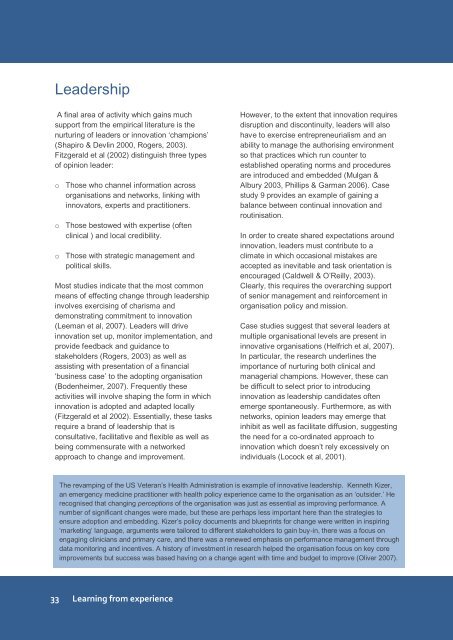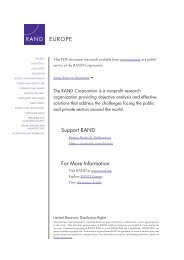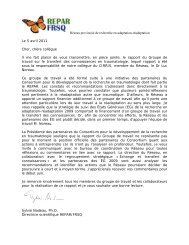Promoting and Embedding Innovation
Promoting and Embedding Innovation
Promoting and Embedding Innovation
Create successful ePaper yourself
Turn your PDF publications into a flip-book with our unique Google optimized e-Paper software.
Leadership<br />
A final area of activity which gains much<br />
support from the empirical literature is the<br />
nurturing of leaders or innovation „champions‟<br />
(Shapiro & Devlin 2000, Rogers, 2003).<br />
Fitzgerald et al (2002) distinguish three types<br />
of opinion leader:<br />
o Those who channel information across<br />
organisations <strong>and</strong> networks, linking with<br />
innovators, experts <strong>and</strong> practitioners.<br />
o Those bestowed with expertise (often<br />
clinical ) <strong>and</strong> local credibility.<br />
o Those with strategic management <strong>and</strong><br />
political skills.<br />
Most studies indicate that the most common<br />
means of effecting change through leadership<br />
involves exercising of charisma <strong>and</strong><br />
demonstrating commitment to innovation<br />
(Leeman et al, 2007). Leaders will drive<br />
innovation set up, monitor implementation, <strong>and</strong><br />
provide feedback <strong>and</strong> guidance to<br />
stakeholders (Rogers, 2003) as well as<br />
assisting with presentation of a financial<br />
„business case‟ to the adopting organisation<br />
(Bodenheimer, 2007). Frequently these<br />
activities will involve shaping the form in which<br />
innovation is adopted <strong>and</strong> adapted locally<br />
(Fitzgerald et al 2002). Essentially, these tasks<br />
require a br<strong>and</strong> of leadership that is<br />
consultative, facilitative <strong>and</strong> flexible as well as<br />
being commensurate with a networked<br />
approach to change <strong>and</strong> improvement.<br />
However, to the extent that innovation requires<br />
disruption <strong>and</strong> discontinuity, leaders will also<br />
have to exercise entrepreneurialism <strong>and</strong> an<br />
ability to manage the authorising environment<br />
so that practices which run counter to<br />
established operating norms <strong>and</strong> procedures<br />
are introduced <strong>and</strong> embedded (Mulgan &<br />
Albury 2003, Phillips & Garman 2006). Case<br />
study 9 provides an example of gaining a<br />
balance between continual innovation <strong>and</strong><br />
routinisation.<br />
In order to create shared expectations around<br />
innovation, leaders must contribute to a<br />
climate in which occasional mistakes are<br />
accepted as inevitable <strong>and</strong> task orientation is<br />
encouraged (Caldwell & O‟Reilly, 2003).<br />
Clearly, this requires the overarching support<br />
of senior management <strong>and</strong> reinforcement in<br />
organisation policy <strong>and</strong> mission.<br />
Case studies suggest that several leaders at<br />
multiple organisational levels are present in<br />
innovative organisations (Helfrich et al, 2007).<br />
In particular, the research underlines the<br />
importance of nurturing both clinical <strong>and</strong><br />
managerial champions. However, these can<br />
be difficult to select prior to introducing<br />
innovation as leadership c<strong>and</strong>idates often<br />
emerge spontaneously. Furthermore, as with<br />
networks, opinion leaders may emerge that<br />
inhibit as well as facilitate diffusion, suggesting<br />
the need for a co-ordinated approach to<br />
innovation which doesn‟t rely excessively on<br />
individuals (Locock et al, 2001).<br />
The revamping of the US Veteran‟s Health Administration is example of innovative leadership. Kenneth Kizer,<br />
an emergency medicine practitioner with health policy experience came to the organisation as an „outsider.‟ He<br />
recognised that changing perceptions of the organisation was just as essential as improving performance. A<br />
number of significant changes were made, but these are perhaps less important here than the strategies to<br />
ensure adoption <strong>and</strong> embedding. Kizer‟s policy documents <strong>and</strong> blueprints for change were written in inspiring<br />
„marketing‟ language, arguments were tailored to different stakeholders to gain buy-in, there was a focus on<br />
engaging clinicians <strong>and</strong> primary care, <strong>and</strong> there was a renewed emphasis on performance management through<br />
data monitoring <strong>and</strong> incentives. A history of investment in research helped the organisation focus on key core<br />
improvements but success was based having on a change agent with time <strong>and</strong> budget to improve (Oliver 2007).<br />
33 Learning from experience
















